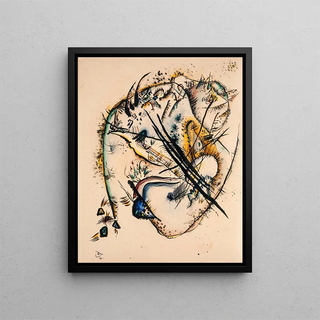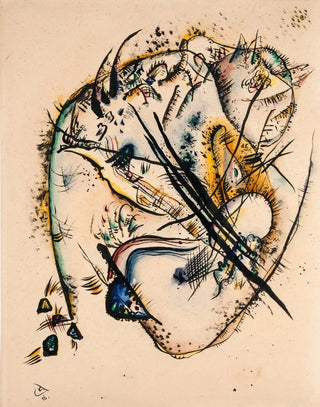Art print | Watercolor with seven strokes - Wassily Kandinsky Source: Reproduction | Aquarelle à sept traits - Wassily Kandinsky


View from behind

Frame (optional)
Introduction captivante
The artwork "Aquarelle à sept traits" by Wassily Kandinsky stands as a true masterpiece of abstract art, a celebration of color and form that transcends the boundaries of imagination. In this watercolor, the artist invites us to dive into a universe where emotions come to life through delicate and vibrant strokes. Each brushstroke seems to dance on the paper, revealing a subtle harmony between spontaneity and reflection. This iconic piece, often regarded as a manifesto of abstraction, encourages us to reevaluate our perception of art and explore the depths of our sensitivity.
Style and uniqueness of the work
Kandinsky's style in "Aquarelle à sept traits" is both bold and poetic. The artist employs a palette of vivid colors that interact dynamically, creating a captivating visual dialogue. The forms, although stripped of any figurative representation, evoke a sense of movement and fluidity. The seven strokes that compose this piece are not mere lines; they are vectors of energy, carriers of emotions that transcend verbal language. Every element of the composition seems to be in constant evolution, prompting the viewer to immerse themselves in this unique sensory experience. The absence of recognizable shapes allows each person to interpret the work through the prism of their own emotions, making this watercolor a deeply personal and universal piece at the same time.
The artist and his influence
Wassily Kandinsky, an emblematic figure of the avant-garde movement, revolutionized the artistic landscape of the 20th century. Born in Russia, he was one of the first to move away from traditional conventions to embrace abstraction. His innovative vision is based on the idea that color and form can express feelings and ideas without resorting to figurative representation. Kandinsky was also influenced by music, which he considered a major source of inspiration for his work. This synesthetic approach, where sounds and colors blend, is reflected in "Aquarelle à sept traits," where each nuance seems to resonate with a

Matte finish

View from behind

Frame (optional)
Introduction captivante
The artwork "Aquarelle à sept traits" by Wassily Kandinsky stands as a true masterpiece of abstract art, a celebration of color and form that transcends the boundaries of imagination. In this watercolor, the artist invites us to dive into a universe where emotions come to life through delicate and vibrant strokes. Each brushstroke seems to dance on the paper, revealing a subtle harmony between spontaneity and reflection. This iconic piece, often regarded as a manifesto of abstraction, encourages us to reevaluate our perception of art and explore the depths of our sensitivity.
Style and uniqueness of the work
Kandinsky's style in "Aquarelle à sept traits" is both bold and poetic. The artist employs a palette of vivid colors that interact dynamically, creating a captivating visual dialogue. The forms, although stripped of any figurative representation, evoke a sense of movement and fluidity. The seven strokes that compose this piece are not mere lines; they are vectors of energy, carriers of emotions that transcend verbal language. Every element of the composition seems to be in constant evolution, prompting the viewer to immerse themselves in this unique sensory experience. The absence of recognizable shapes allows each person to interpret the work through the prism of their own emotions, making this watercolor a deeply personal and universal piece at the same time.
The artist and his influence
Wassily Kandinsky, an emblematic figure of the avant-garde movement, revolutionized the artistic landscape of the 20th century. Born in Russia, he was one of the first to move away from traditional conventions to embrace abstraction. His innovative vision is based on the idea that color and form can express feelings and ideas without resorting to figurative representation. Kandinsky was also influenced by music, which he considered a major source of inspiration for his work. This synesthetic approach, where sounds and colors blend, is reflected in "Aquarelle à sept traits," where each nuance seems to resonate with a






